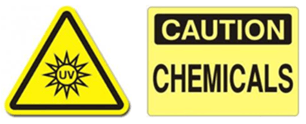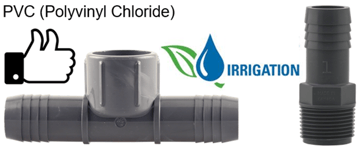What to consider when selecting a plastic insert fitting?
What to consider when selecting a plastic insert fitting?
In this article we will cover the strengths and weaknesses of nylon, poly, and PVC insert fittings.
NYLON:
 Strengths
Strengths
Nylon is the toughest of the three materials. It is great for water well and underground (trench) applications. It is durable for back filling, and other applications like barns, livestock, and watering systems as it will take the greatest abuse - stretching, twisting, etc.

 Weaknesses
Weaknesses
Nylon is not suited for exposure to sunlight. Ultraviolet rays will cause the fittings to become brittle. A smaller range of chemicals are suitable with nylon.
POLY:
 Strengths
Strengths
Poly is the most economical of the three materials. It has good chemical resistance and is used widely in the pool and spa market. Poly fittings are used with some chemicals that are not suited to PVC.

 Weaknesses
Weaknesses
Poly is the least durable of the three materials. Less items are available in reducing fittings.
PVC:
Strengths
PVC has the widest range of fittings. It is suitable for irrigation applications since it is not affected by ultraviolet. Having good chemical resistance, PVC fittings are used with some fluids which poly fittings are not compatible with such as such as lubrication oils.


 Weaknesses
Weaknesses
PVC has no noteworthy weaknesses; however, it is more expensive than poly!
Why are PVC insert fittings used for irrigation installations?
 PVC insert fittings are best suited for irrigation applications since they are not affected by ultraviolet, have good chemical resistance, and are tougher than poly fittings!
PVC insert fittings are best suited for irrigation applications since they are not affected by ultraviolet, have good chemical resistance, and are tougher than poly fittings!
However, most importantly, PVC inserts are used in irrigation systems where lines are not buried below the frost level. These water lines must be winterized by blowing out the water to prevent damage from freezing. Since it is not always possible to remove 100% of the water due to the rise and fall of the pipe, water can be left in low lying fittings and could freeze.
PVC fittings are very rigid and are best suited out of the three materials to ensure that the expansion of the ice will be forced lengthwise out of the fitting into the pipe instead of expanding the diameter of the fittings. This ensures the pipe and gear clamps will maintain a positive seal.
![]() Nylon fittings, although being the toughest material overall, are not suited for this particular application due to the fact that nylon will stretch in diameter under this circumstance. This stretching can loosen the clamp, and because nylon has a memory, it will return to its original size when it unthaws resulting in a loosened connection, possibly causing a leak.
Nylon fittings, although being the toughest material overall, are not suited for this particular application due to the fact that nylon will stretch in diameter under this circumstance. This stretching can loosen the clamp, and because nylon has a memory, it will return to its original size when it unthaws resulting in a loosened connection, possibly causing a leak.
Additional Resources.
https://support.boshart.com/insert-fitting-pull-off-resistance-testing
